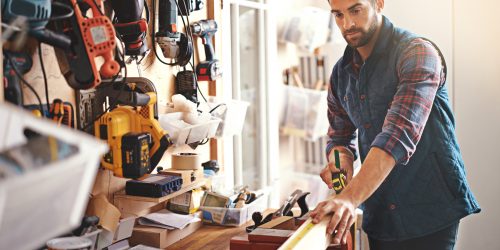Purchasing guide: How to choose your air cooler for your company?
Faced with increasingly frequent heat waves in recent years, companies are looking for ways to maintain a comfortable temperature on their premises. They’re also concerned about the air quality, which must be free of pollutants or contaminants while providing the right humidity levels. How can you fulfill these requirements for temperature control and improved air quality while keeping your budget under control? Air coolers provide an inexpensive, effective, and convenient solution. Find out how to choose an air cooler among the available models in this air cooler purchasing guide.
How does an air cooler work?
Air coolers work by evaporative water cooling, a natural process. Also known as an “air refresher”, this device draws in ambient air, which passes through a permanently moist pad. The water in the pad evaporates, cooling the air coming out of the machine. This cooling system is complemented by a ventilation system, which allows air flows to circulate around the room.
They differ from conventional fans, which stir hot ambient air, in that they change the air temperature by evaporation. To keep the pad moist, the unit has a tank of variable capacity. It should be noted that the room’s base humidity is a factor in how effective the air cooler is. The warmer and drier the air, the greater the feeling of freshness brought by humidifying the room.
These devices generally have quite a simple design and they are also easy to use, as the priority is to fulfill the functional need for cooling or air purification. Air coolers for the workplace vary in size to suit different types of use.
For offices, it is advised to opt for a portable air cooler. Equipped with wheels or a carrying handle, users can easily move it from room to room. There is also a “mini” model you can place on a desk and connect via a USB port, which is ideal for remote working.
Warehouse air coolers are designed to cool the air in larger areas. They can even be used to lower the ambient temperature in very large spaces (80 to 150 m²).
Criteria for buying an air cooler
Using this air cooler purchasing guide, identify the factors to consider (constraints of the space to be cooled, room size, users’ needs) when making your choice from the air cooler models available.
Product Features
To choose a suitable air cooler for offices, the following key criteria must be considered:
- The volume and number of rooms to be cooled;
- The water tank capacity;
- The appliance’s air flow rate and fan speed;
- Its energy consumption;
- Its noise level in decibels;
- Whether it has an air purification option;
- Whether it has an automatic stop timer.
Your company’s specific needs
Air cooling needs are specific to each location, depending on its size, layout, and insulation quality. Some work areas are therefore affected very quickly if there is intense heat. Regulating the temperature of the premises is one of the priorities for providing good working conditions in a heat wave. The advantage of an air cooler is that it works quickly and can be used as a mobile backup solution.
During the health crisis, the authorities widely communicated the importance of ventilating enclosed spaces properly for safety at work. Although this precaution has fortunately become a habit, it’s not always an option to open a window in the middle of the day if there are high temperatures. If your company wants to complement its internal ventilation system, it is advisable to equip the premises with an air cooler that acts as an air purifier. The device can be fitted with either a filter or an ionising system.
What are the advantages of an air cooler?
The air cooler’s operating principles also make it an air humidifier, a real asset for improving well-being at work. Working in an environment that is too dry or too humid is a source of discomfort for employees. Air that is too dry in the office can cause dry throats or eye irritation. Too much humidity, on the other hand, can lead to mould and respiratory problems for some people.
The air cooler has several advantages over air conditioning. Eco-friendlier and more energy efficient, it is also more economical, which is reflected in your electricity bill. Unlike air conditioners, air coolers do not use refrigerant. This liquid contains substances that are considered harmful to the ozone layer and contributes to the greenhouse effect.
Installing an air cooler is also much easier, as it’s a mobile device that can be easily stored when not in use. In comparison, installing an air conditioner requires work and space replanning. Finally, air cooler operation causes less noise pollution than an entry-level air conditioner.
The different air cooler options
You must know the options offered by the different models to choose the most suitable unit for the room you want to cool.
Water tank capacity
The first step is to assess the water tank capacity required. This determines how often the appliance will be refilled. The larger the water tank, the less often the appliance needs to be refilled.
Night mode
Another way to increase the refill time is to choose an air cooler with a night mode. This is a slow-running mode, which is used to maintain the cool temperature for longer without human involvement. It can also be used for its energy-saving, quieter operation than normal mode. Night mode is one of the power levels available on models with adjustable fan speeds.
Air purifier option
As mentioned above, air coolers can act as air purifiers. The unit is then equipped with a filter or an ionising system. The filter can be electrostatic, which removes pollutants, dust, pollen, and bacteria. The carbon filter – also found in extractor hoods or dustbins – combats bad odours.
The ioniser option is an air purification technique where fine particles in the air become heavier when mixed with negative ions and fall to the ground. Lastly, some units feature an oscillating ventilation option to distribute the fresh air around the room and produce an effect similar to the natural wind.
Associated Accessories
The next decision involves the user-friendliness of the unit. The control panel on the air cooler can be equipped with conventional buttons, a touch screen, or a display. The appliance can also be used with a remote control. This allows the user to change settings (power, oscillation) and select operating modes remotely.
Some models have an integrated timer for greater automation. This option is designed for more economical electricity use by ensuring that the appliance will automatically switch off once the programmed number of operating hours has elapsed.
Additional cooling methods
The way air coolers work is through the water in the appliance, as mentioned above. However, the cooling effect can be increased in some models by the use of ice. You can add ice cubes when the unit is fitted with an ice tray.
Other models have an ice pack slot and are sold with multiple ice packs, which can be placed in the air cooler on an alternating basis. These additional evaporative cooling methods mean it is longer before the tank has to be refilled. This is because the ice has to melt before the water starts to evaporate.
Cooler maintenance
As with any electrical appliance, an air cooler needs regular maintenance to ensure that it is working at its best. Of course, before cleaning, the air cooler should be unplugged to avoid any electrical hazards.
Clean the air filter
Since it blows air into the room, it is important to ensure that it is free of dust. To clean the air filter, you just need to follow the instructions in the user manual.
This is usually done by removing most of the dust with a vacuum cleaner and then cleaning the filter with soapy water. Make sure you let the filter dry before putting it back in the unit.
Clean the humidifier pad
The humidifier pad should be cleaned at least once a month, as it can develop mould or scale. It should be washed with soap (or washing-up liquid), and care should be taken not to damage it.
Clean the water tank
The water tank should not be neglected, as it is also susceptible to limescale build-up and even mould. You should regularly change the water it contains and clean it with a sponge or brush, especially if the water contains high levels of limescale.
In addition to this regular maintenance, it is important to clean the air cooler thoroughly if it is not going to be used for a while. After the filter, tank, and pad have air-dried, you just have to reassemble everything.
To improve the working conditions of your teams by looking after their environment, you can also choose to equip yourself with air treatment devices. In hot weather, good hydration is essential. A water fountain is a great solution so your employees can drink enough without using plastic bottles, which are a source of waste.
Discover our complete range of products to cope with a heat wave at work.






